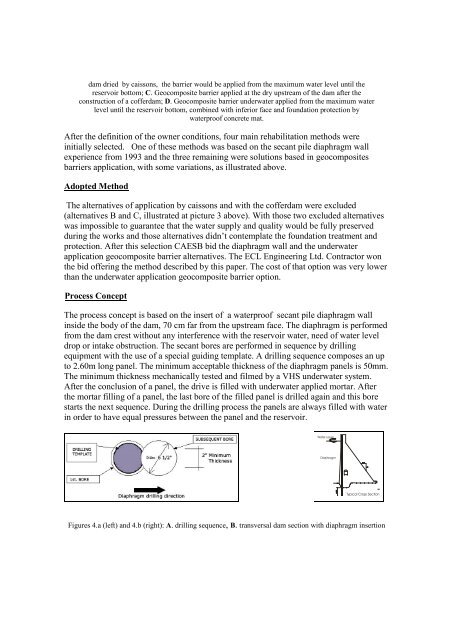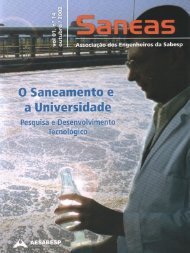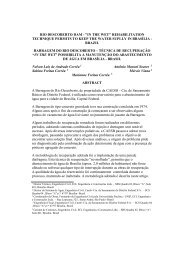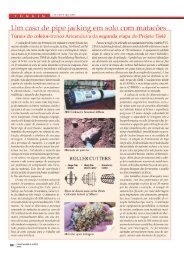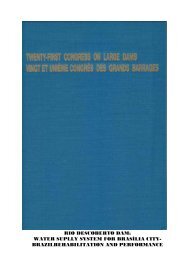USSD Rio Descoberto Dam - Sabino Freitas Correa-ENGL -
22nd US Society of Dams International Meeting Published - Rio Descoberto Dam - Rehabilitation Technique Permits to Keep Water Supply in Brasília - Brazil - Corrêa, Nelson, Corrêa Marianne, Sabino Freitas Correa, Soares,A., Viana,M.
22nd US Society of Dams International Meeting Published - Rio Descoberto Dam - Rehabilitation Technique Permits to Keep Water Supply in Brasília - Brazil - Corrêa, Nelson, Corrêa Marianne, Sabino Freitas Correa, Soares,A., Viana,M.
You also want an ePaper? Increase the reach of your titles
YUMPU automatically turns print PDFs into web optimized ePapers that Google loves.
dam dried by caissons, the barrier would be applied from the maximum water level until the<br />
reservoir bottom; C. Geocomposite barrier applied at the dry upstream of the dam after the<br />
construction of a cofferdam; D. Geocomposite barrier underwater applied from the maximum water<br />
level until the reservoir bottom, combined with inferior face and foundation protection by<br />
waterproof concrete mat.<br />
After the definition of the owner conditions, four main rehabilitation methods were<br />
initially selected. One of these methods was based on the secant pile diaphragm wall<br />
experience from 1993 and the three remaining were solutions based in geocomposites<br />
barriers application, with some variations, as illustrated above.<br />
Adopted Method<br />
The alternatives of application by caissons and with the cofferdam were excluded<br />
(alternatives B and C, illustrated at picture 3 above). With those two excluded alternatives<br />
was impossible to guarantee that the water supply and quality would be fully preserved<br />
during the works and those alternatives didn’t contemplate the foundation treatment and<br />
protection. After this selection CAESB bid the diaphragm wall and the underwater<br />
application geocomposite barrier alternatives. The ECL Engineering Ltd. Contractor won<br />
the bid offering the method described by this paper. The cost of that option was very lower<br />
than the underwater application geocomposite barrier option.<br />
Process Concept<br />
The process concept is based on the insert of a waterproof secant pile diaphragm wall<br />
inside the body of the dam, 70 cm far from the upstream face. The diaphragm is performed<br />
from the dam crest without any interference with the reservoir water, need of water level<br />
drop or intake obstruction. The secant bores are performed in sequence by drilling<br />
equipment with the use of a special guiding template. A drilling sequence composes an up<br />
to 2.60m long panel. The minimum acceptable thickness of the diaphragm panels is 50mm.<br />
The minimum thickness mechanically tested and filmed by a VHS underwater system.<br />
After the conclusion of a panel, the drive is filled with underwater applied mortar. After<br />
the mortar filling of a panel, the last bore of the filled panel is drilled again and this bore<br />
starts the next sequence. During the drilling process the panels are always filled with water<br />
in order to have equal pressures between the panel and the reservoir.<br />
Figures 4.a (left) and 4.b (right): A. drilling sequence, B. transversal dam section with diaphragm insertion


